This edition of the blog is brought to you from Cuenca, a beautifully kept colonial town in the south of Ecuador, where the architecture makes us feel like we’ve been transported back to Europe! It’s Ecuador’s third largest city and easily the most liveable place we’ve been. If the book shelves in yesterday’s cafe are anything to go by, it’s certainly a favourite with the digital nomads of the tech world. In this post we start in Salinas de Guaranda and climb up to the snow line on Chimborazo, spend a few more riding days in the Ecuadorean highlands before starting the gradual approach to the Peruvian border.
Our decision to take a rest day in Salinas seemed perfectly timed as we woke up on departure day to clear skies. Our panniers full of artisanal cheese, ham and chocolate, a quick trip to the panaderia for bread and we were ready. For the climb to Chimborazo we were joined by Walter, whose company, humour and shared snack bag made the horrendous wind slightly more bearable. It was interesting how the company of a third person brings a new dynamic and helped to make things a bit more playful. Chimborazo would mark the highest point of our trip so far, the summit of the volcano (6, 263m) is famously the closest point to the sun thanks to a bulge in the Earth’s crust at the equator and would be the highest point either one of us or our bicycles have ever travelled (which is exciting but the thought alone makes you feel a little breathless!).
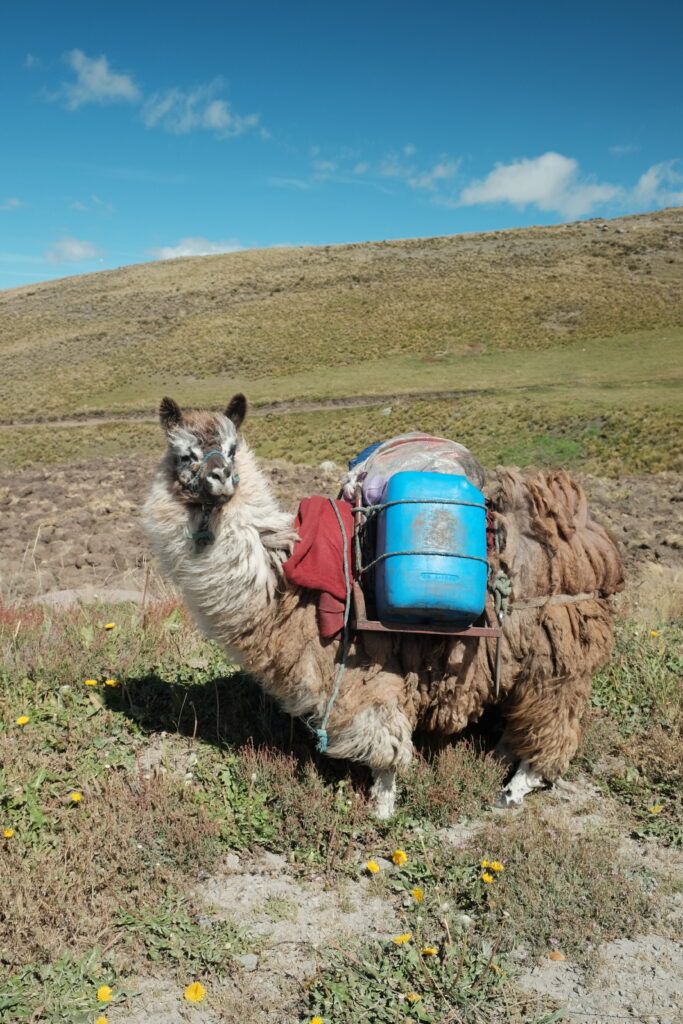
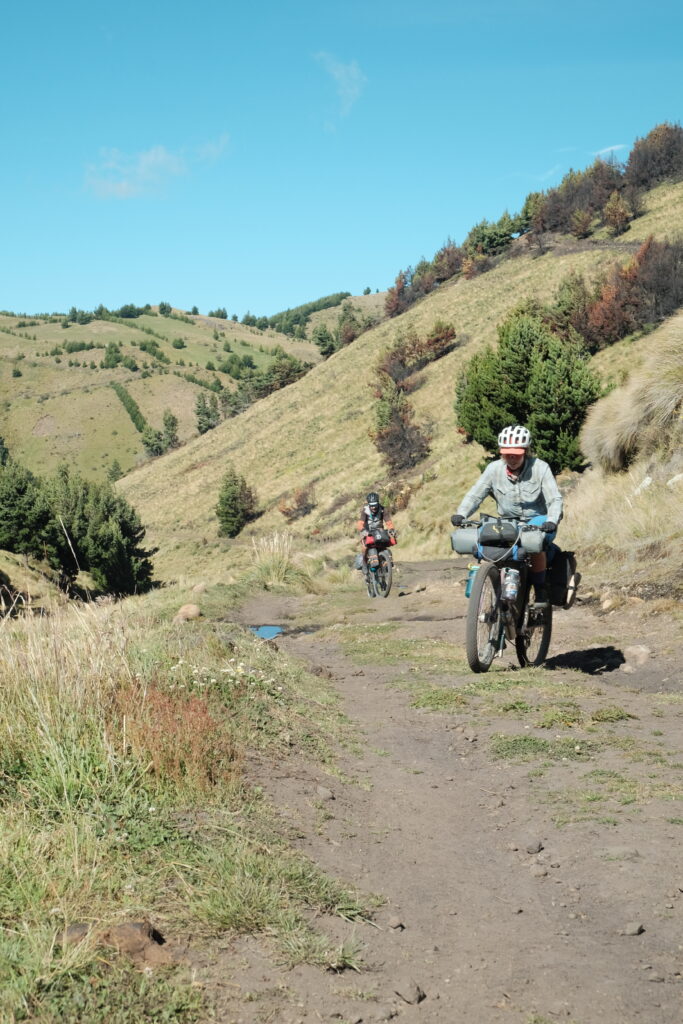
Pretty much as soon as we’d left the town of Salinas and pointed our front wheels up the valley, the wind made her presence known. This would be one of the main features of the day, blowing up volcanic dust which stuck to our sun cream making us all look like we’d been down the pit. The double track was sublime and we soon got a teaser of Chimborazo’s snow capped summit contrasted against the clear blue sky. She came into full view as we crested the first pass and we enjoyed stopping for photos and laughing at how dirty our faces were.

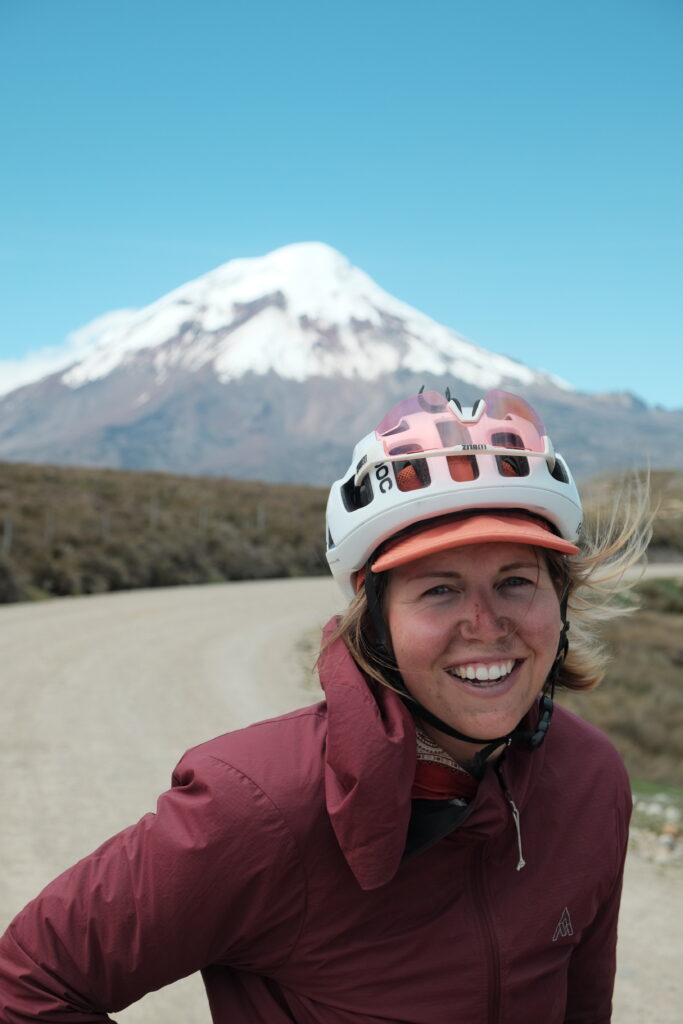
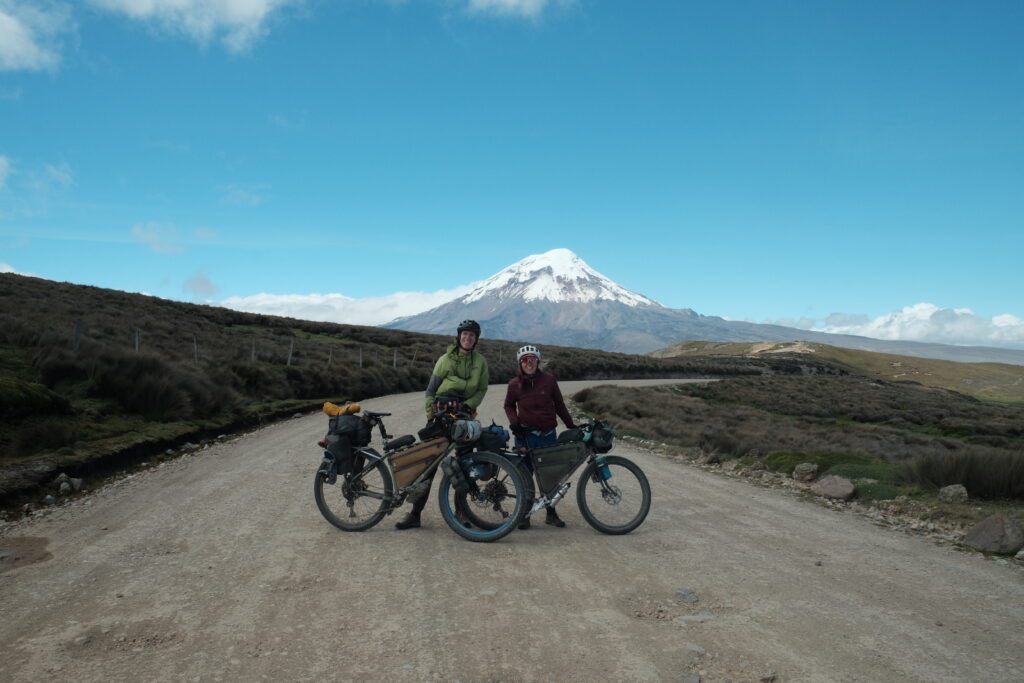
We sheltered for lunch behind a wall at the park entrance and tried not to over-think the next part of the ride: climbing up to the refugio at 4,800 meters above sea level. Thankfully, the switchbacks on the climb meant the gradient was manageable and changed up the wind direction so we got the odd tail wind to help morale. We saw plenty of vicuñas on the high Andean planes, these wild relatives to Alpacas and Llamas are much more timid and agile, so we only got to appreciate them from a distance.

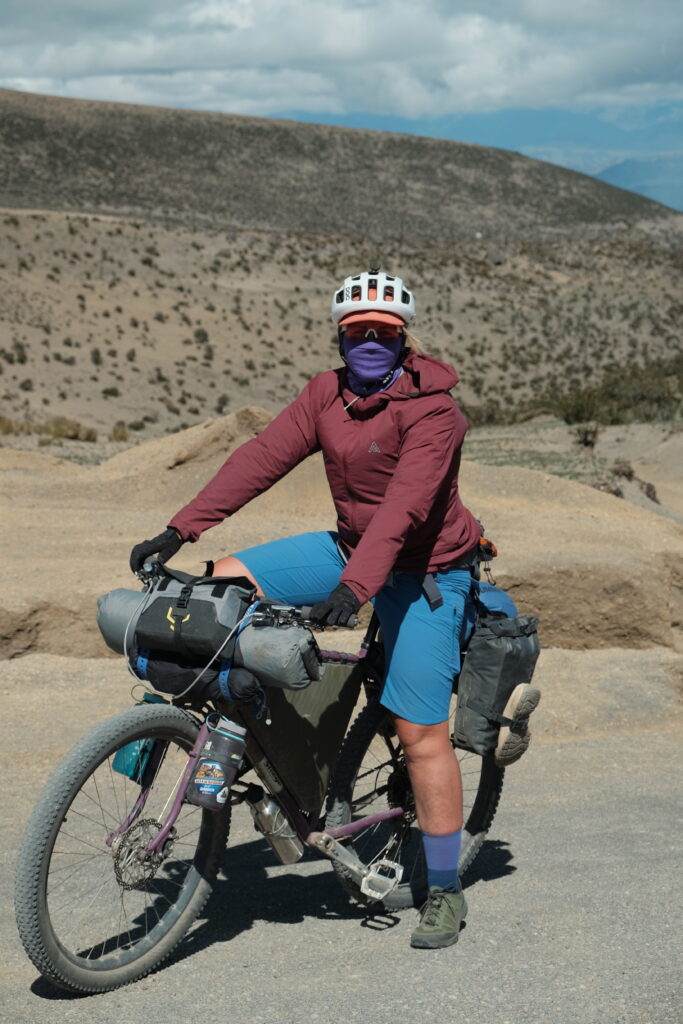
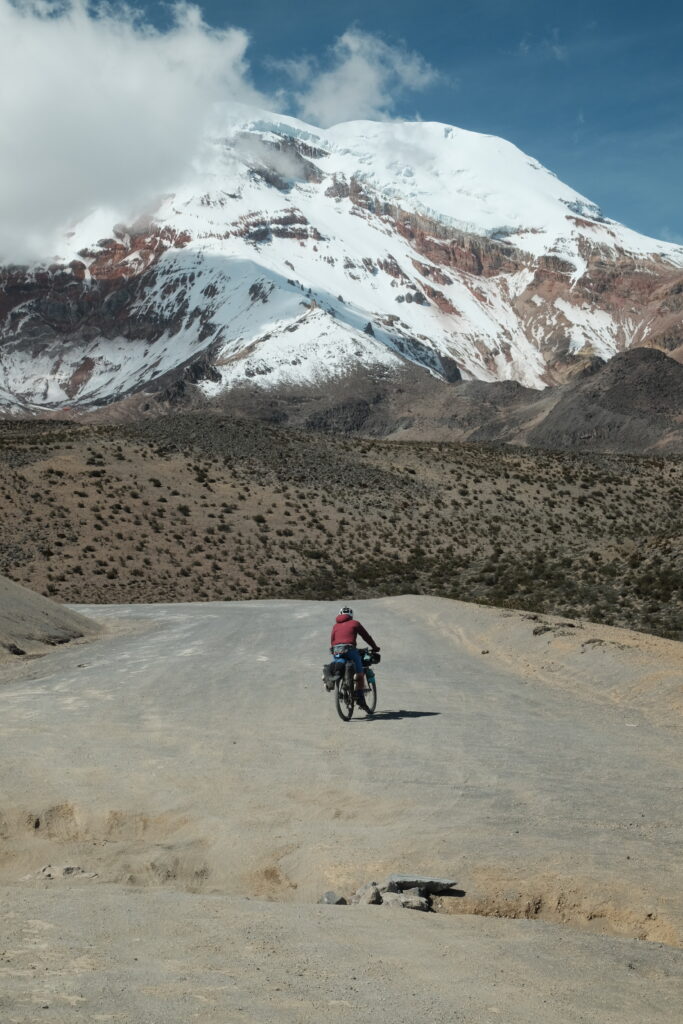
Eventually reaching the refugio we rewarded ourselves with coca tea to help with the altitude, I’m not sure it did much but it was certainly quite fruity! Finally out of the wind and elements, we began to discuss if it was sensible to sleep in the tent that night. Camping at the refugio is free, but the designated pitch only featured a DIY drystone wall for shelter from the wind. Keen to tick off a high altitude camp and test our setup in these conditions (we’d probably spend half our time in the Puna building wind protection for the tent) we ventured back outside while Walter favoured the $30 bed and half board at the refugio. Thankfully the wind didn’t pick up overnight and we were treated to a fabulous frosty, starry sky and some great views of Chimbo in the evening, moon and morning light.
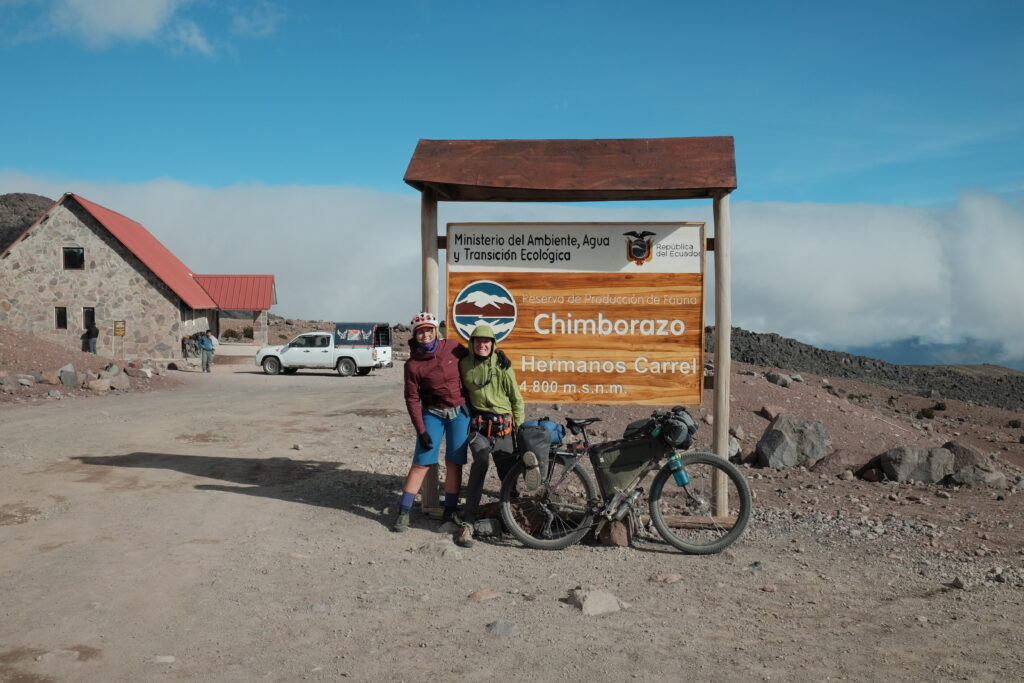
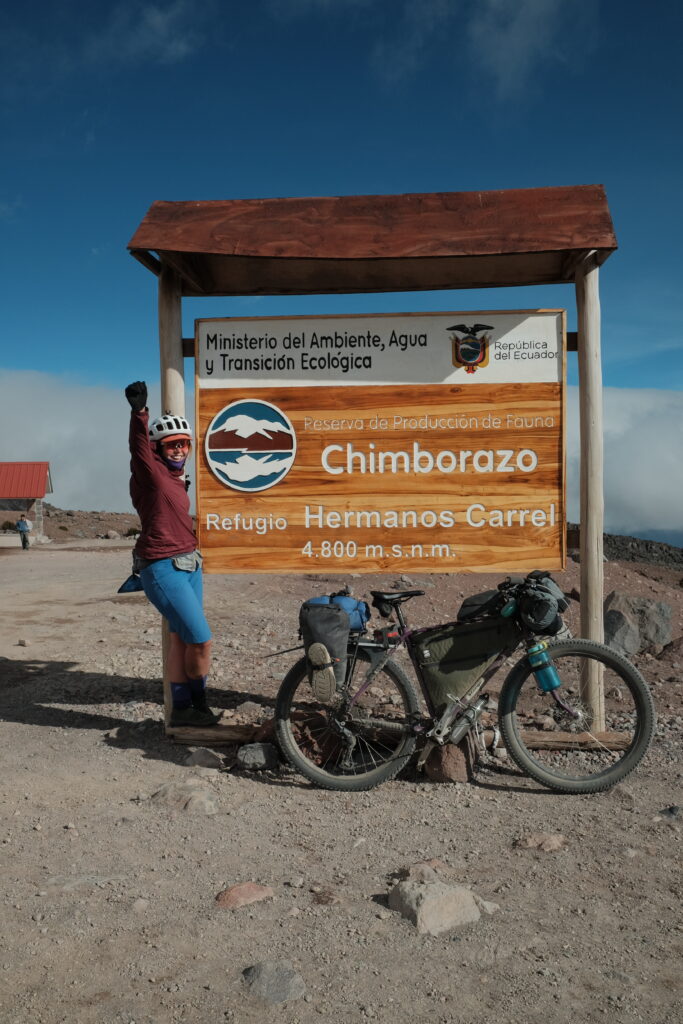



Waking up to another perfect, cloud free summit day on Chimborazo, Liam and I walked up to the next refuge and on up to the snow line at around 5,100m. A lifetime high for both of us.

Walter had already left the refugio to continue on the TEMBR route and we had decided that given the prefect conditions it might be time to give the slightly more technical Tres Volcanoes route another chance. Although we had been bitten before by the gruelling hike a bike up to the Quilotoa crater lake, the hoards of poncho clad tourists loudly disembarking from their busses nudged us towards taking the track less travelled. Just to be sure we weren’t being total fools we checked the HighLux blog to get an idea of what might come as we traversed the valley north of the volcano. They had summarised the riding here as ‘excellent’ as the route picked up a sometimes technical horse track and while they did mention wet and boggy ground they also mentioned that it did not slow them down much. Well reader, a lot can change in 5 years!
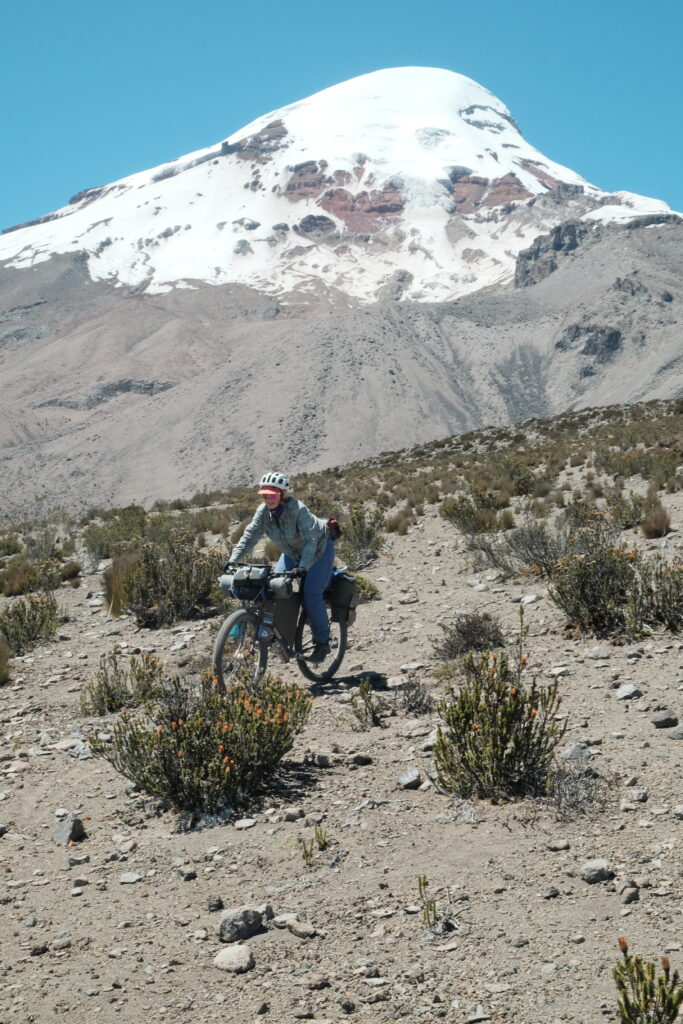

Descending the volcano we took a technical single trail negotiating boulder fields and a trail running race. Feeling a little sheepish at getting in the way of the athletes, we could at least cheer them on and answer their questions about how many runners there were ahead of them. Eventually we peeled off and joined an old 4×4 track down to some sand dunes. I had a very slow motion crash loosing my front wheel in the substrate; sand riding has never been my forte (but thankfully it’s a very soft landing). We took a short road connection to join the Tres Volcanes route and upon turning off the road were met by a lady demanding $2 each for passage onto the track. She appeared so quickly I fell off my bike again (or was it the wind?!). Not convinced, we turned around to take the singletrack/hike a bike that’s in the route to detour to rejoin the track further along. The planes and grassy farmland behind Chimborazo were wild and full of vicuñas, we’d gone from awe at the first sightings to indifferent in the space of a few minutes!
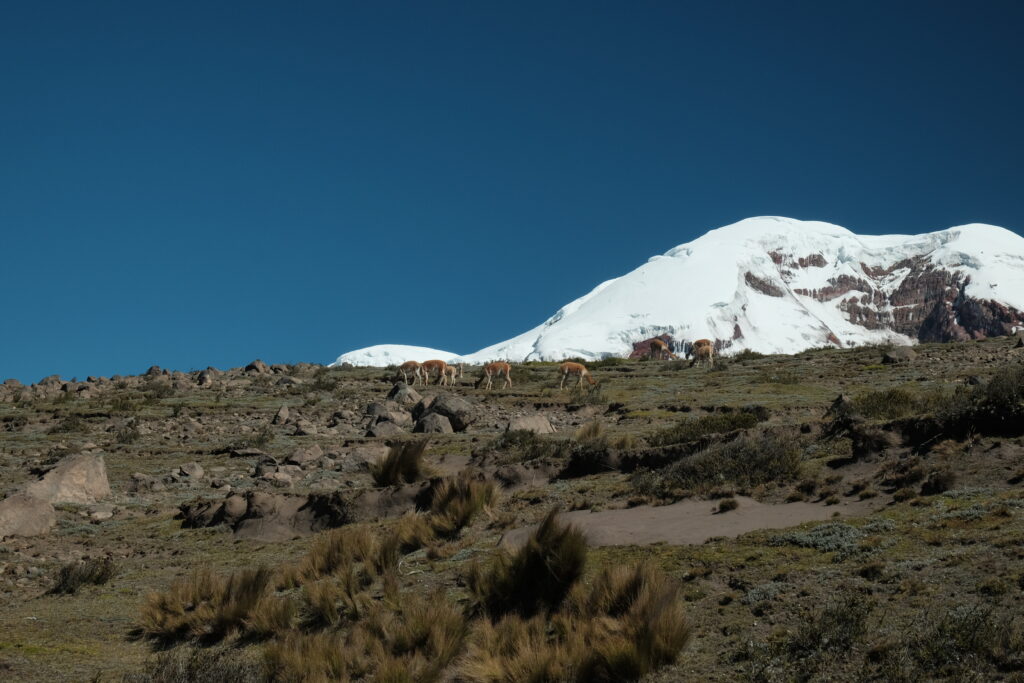
As we came around a corner close to Refugio Carihuairazo, we spied 3 large green busses, so much for taking the less touristy route! It turns out these coaches were there for some sort of hiking event and this was most definitely the end of the tourist track as we followed doubletrack which consistently deteriorated over the next few KMs. Grateful to finally leave the crowd behind us we rode happily onwards into a remote and deserted valley with the most incredible view with Chimborazo on one side and Carihuairazo poking out through the cloud on the other.

The horse track which followed has clearly deteriorated quite significantly since Mark and Hana had come this way – the track was completely unrideable in many parts. We were hauling, heaving and dragging our bikes through boggy ruts and giant puddles for hours. At one point I threw my toys out of the pram, I didn’t want to be doing this anymore. It was so physical negotiating these massive ruts with a fully loaded bike and my upper body was just exhausted. After the windy, high altitude efforts of the previous day my lower limbs were pretty knackered as well! It was such a shame that the track was so eroded because it was such a breathtakingly beautiful valley, completely empty with views onto the north face of Chimborazo, a laguna below us and the odd vicuña dancing in and out of view.

Eventually we reached the bottom of the deserted valley and the warm evening light urged us to seek out a camp spot. But where on this eternally boggy ground?! We needed to fill up on water (ironically), and the route had us crossing the river (somewhere, there was a barbed wire fence and no bridge) so while Liam carried my bike through a crux I hopped on ahead to find a camp spot. Years of practice at this sometimes comes good and I found us some flat, dry ground right next to a hole in the fence and a narrowing of the river. We’d be able to hop over the following morning with no risk of re-wetting our feet.
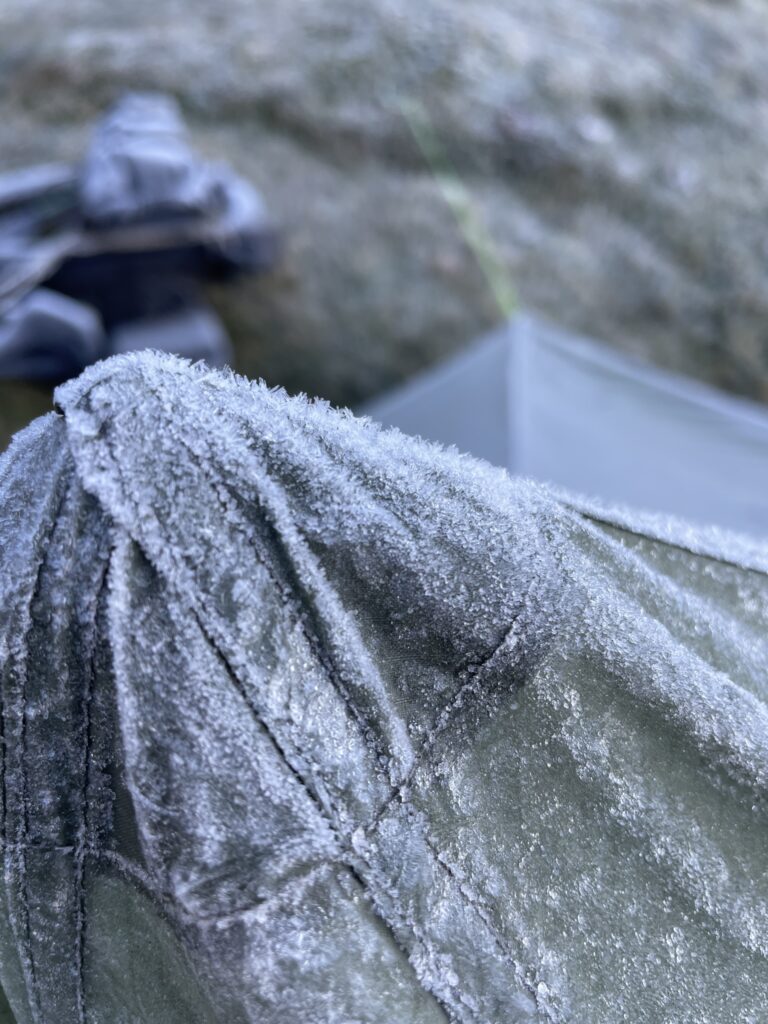
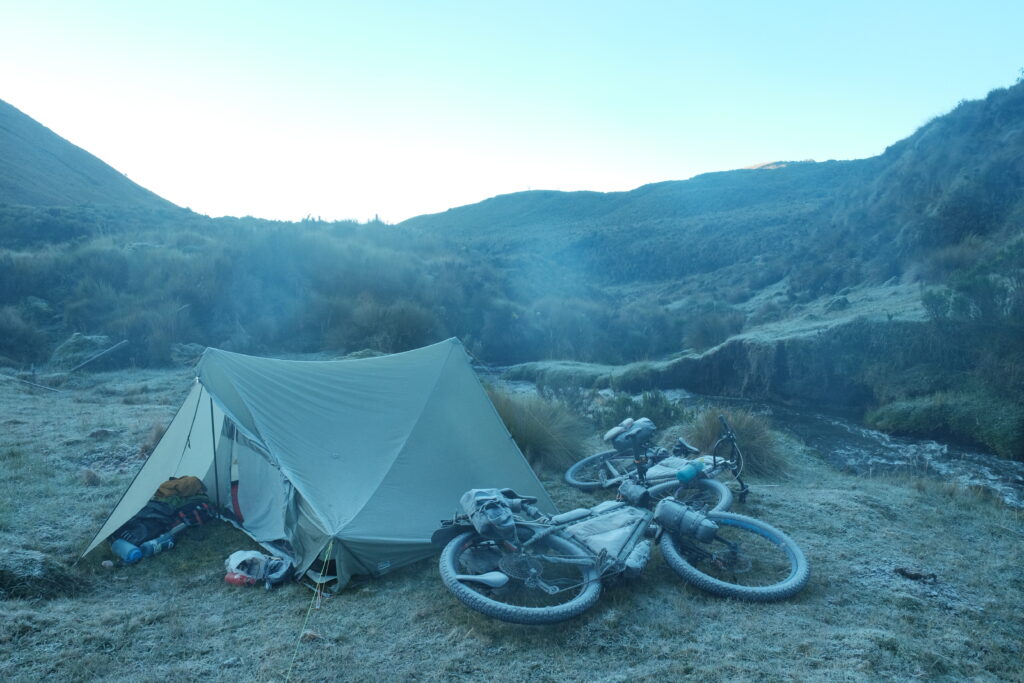
There was clearly a lot more moisture in the atmosphere here we had our first frosty tent in the morning, but we enjoyed being totally alone in this valley and waited for the sun to come up as we ate our porridge. More pushing awaited us to get over a ridge and a boulder field and another melt down occurred before we finally joined a track and were able to enjoy some easy freewheeling as we rejoined the TEMBR route and descended towards our first almuerzo for several days. A slow climb to Cajabamba indicated that a short day was needed to help the bodies recover, so we sought out a hostal and an ice cream. The nature of the trip leads to a sort of feast and famine dynamic, as it’s impossible to carry enough calories for the high mountain sections we often find ourselves binging when we get back into civilisation. Cajabamba is a town with a split personality, an old and run down colonial side of town and a much busier and more bustling side along where the Pan-American highway runs through.


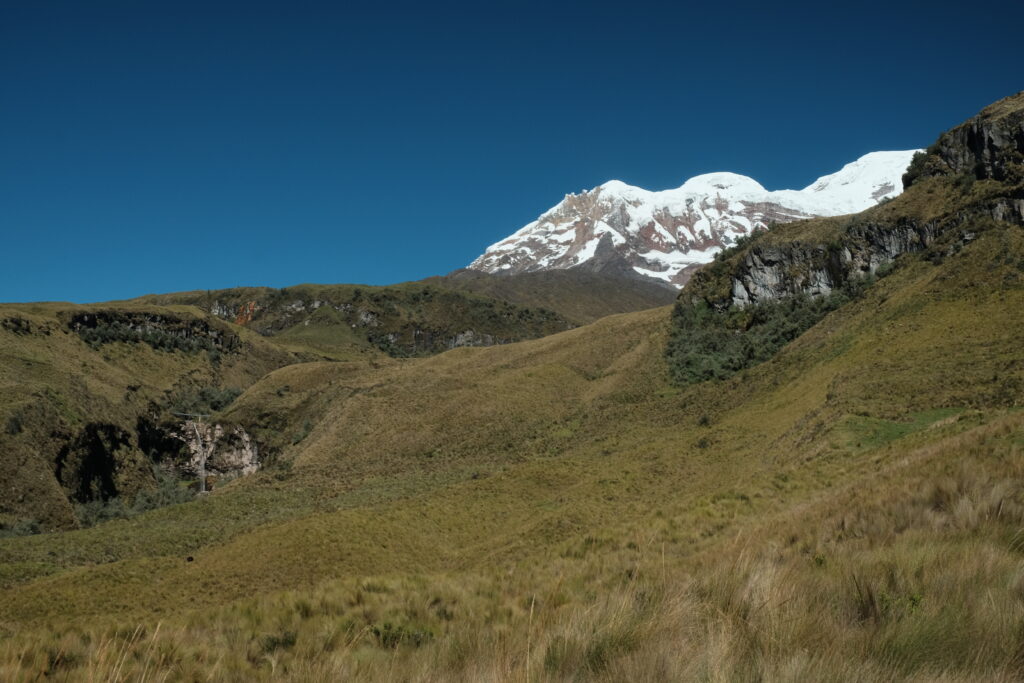
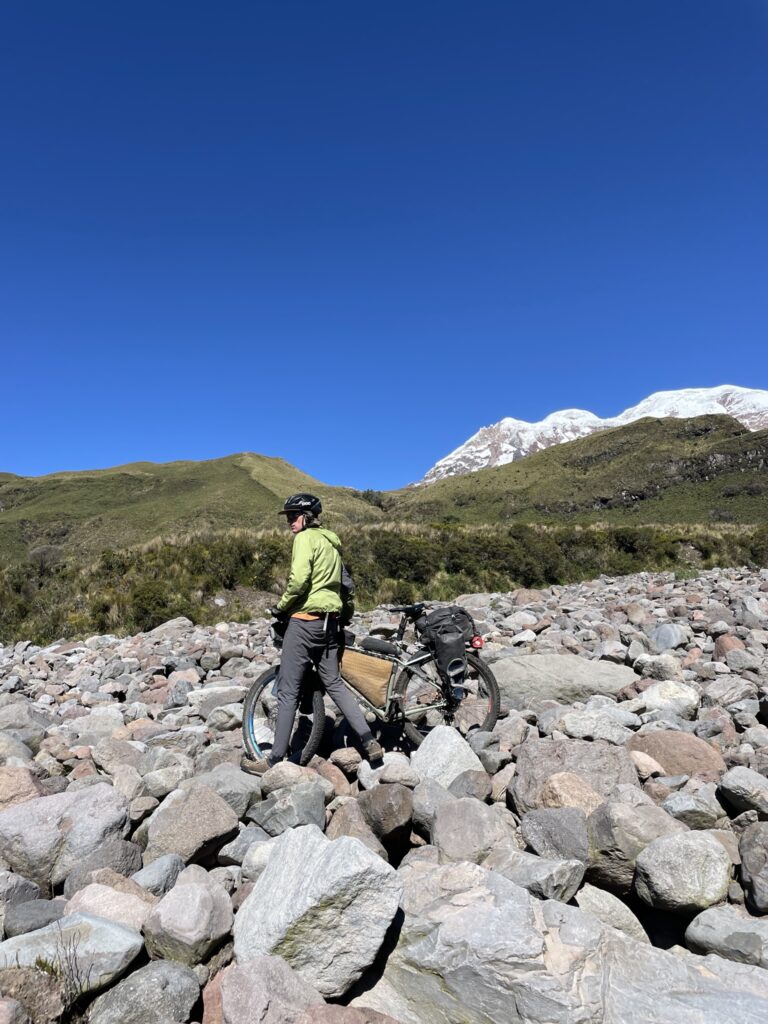
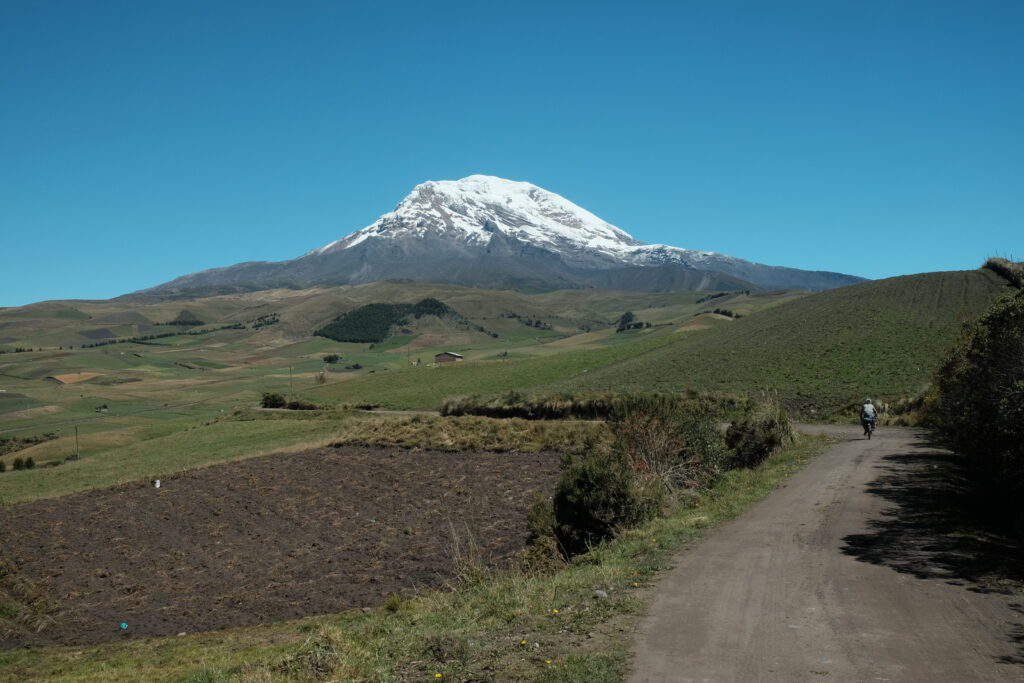
Back in the mountains the following day we passed through Guamote. Unfortunately, we had not timed our ride to coincide with it’s famous market so we settled for resupplying from a tienda. We were caught out by having to buy pasta and oats by weight and not being able to convert to pounds and ounces! No such thing as too many carbs in this game, and it was just as well as the next section to Chunchi took us a day longer than planned thanks again to strong winds and tired bodies.
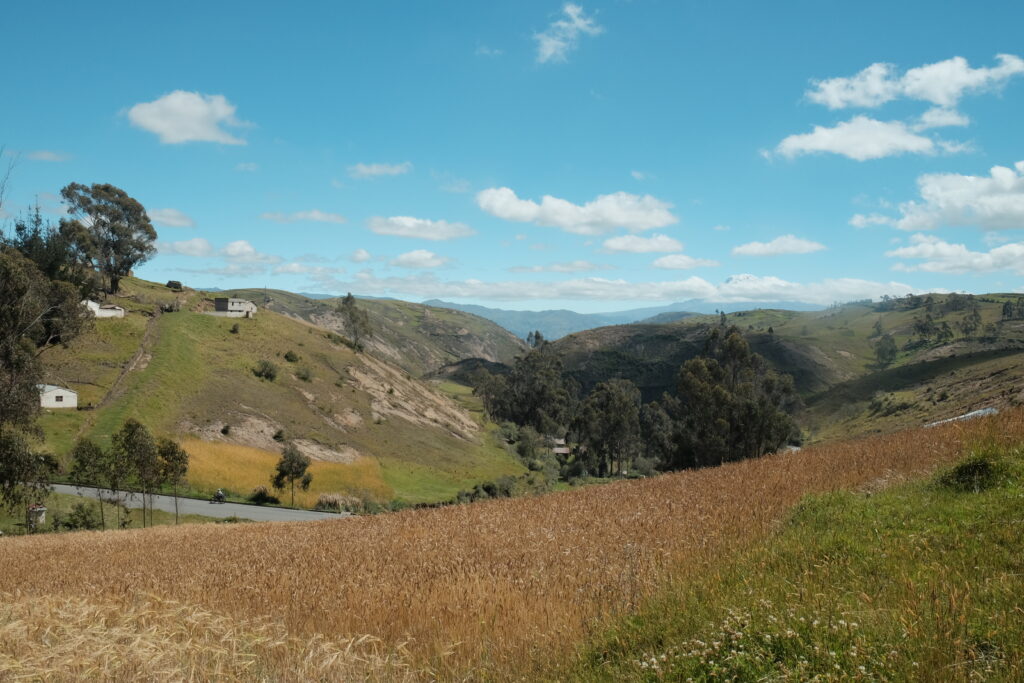
The beginning of the climb out of Guamote was steep and so we elected to camp before summit in the climb, Liam found a patch of flat ground only slightly smaller than the footprint of the tent sheltered by some pine trees. We had filled up on water outside the school of the previous village although a broken pipe meant that our spot actually had it’s own water source! Not completely obscured from the road but the curious and friendly locals would just give a toot of encouragement as they passed. We feel much safer in the hills and much more confident with our wild camping by now that I’m less concerned with being slightly visible.
The following day had us battling the wind again to cross our last expanse of paramo, which caused a little tension as Liam was getting cold as he waited for me. He finally put on some extra layers when we stopped for lunch but by this point the damage was done and he was grumpy!
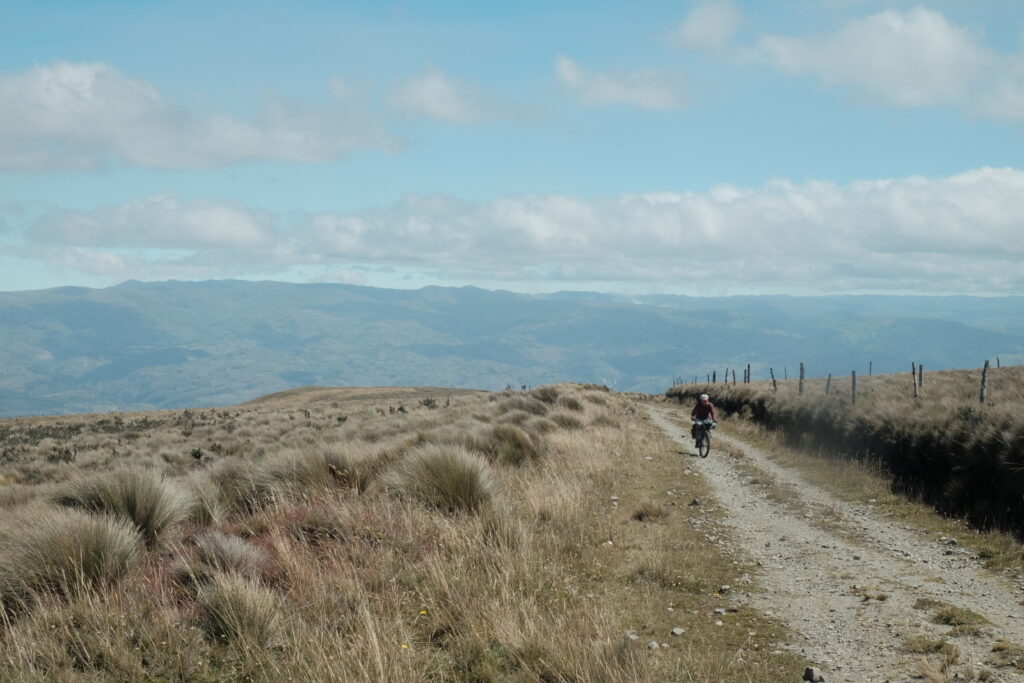
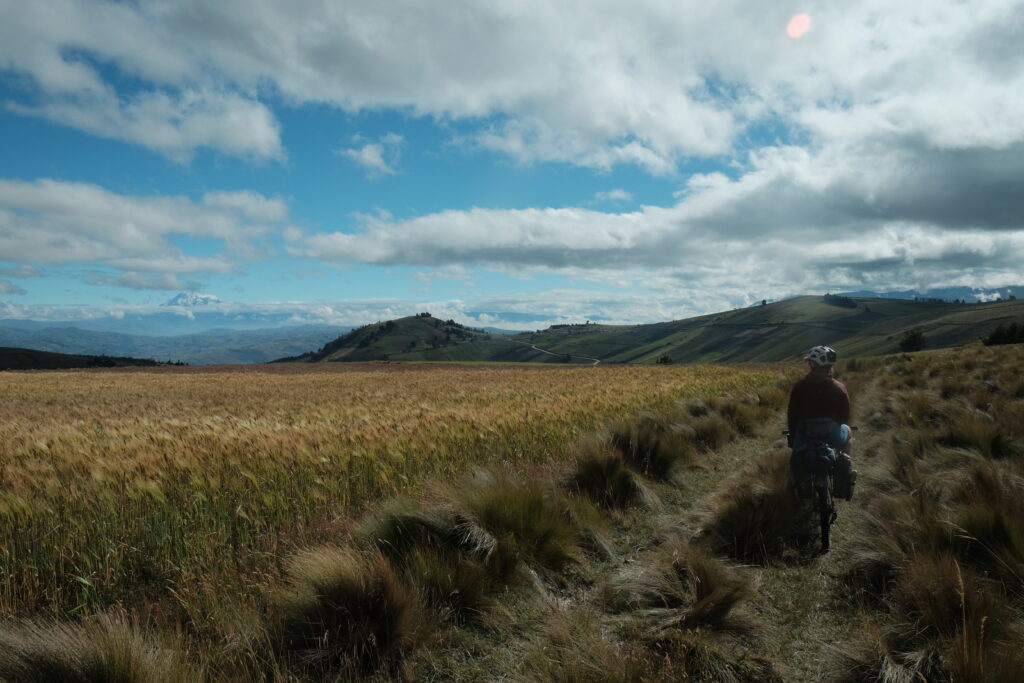
Some shorter, sharper hills as we crossed three small valleys warmed us back up but before we knew it we were filling up at a stream preparing to seek out another camp spot. Unable to find much in the way of flat or sheltered ground we camped near the summit of the final hill this time in full view of the road but completely at ease with this. One collectivo driver stopped to ask us what we were up to, clearly thought we were bonkers and wished us a good trip.
After dinner, just as we were tucking up in bed (Liam was actually half way through changing his clothes!) we heard a gentle ‘Buenas noches’ from outside the tent. As Liam frantically pulled his leggings on I opened the zip of the tent to see three children peering down at us. They were from a nearby farm and had brought us some fresh milk which we eagerly exchanged for some sweeties. The eldest was 14, in traditional Ecuadorean dress and she was carrying her baby sister in a sling on her back with her 4 year old brother by her side, their puppy sneakily trying to snaffle any dregs of milk he could get his tongue on. The children were curious about us, asking a few questions and just being happy to observe us and accept our sweets! As the light faded they headed back home, asking what time we’d be up in the morning. What we did not expect is that at 6am the eldest would be back this time with warm milk and some bread! She hung around as we made coffee and porridge; we offered her some but she insisted she had already had breakfast. She told us how the family had a few cows and horses, that today was market day in a neighbouring village and so that’s why there were slow trucks heading up the hill with heavy cargos of livestock. Curious about how we were travelling we showed her inside the tent and where all the items were stored on our bikes. As we set off that morning we were just in awe of the generosity and kindness shown to us by this Andean family who had so little in comparison to ourselves.
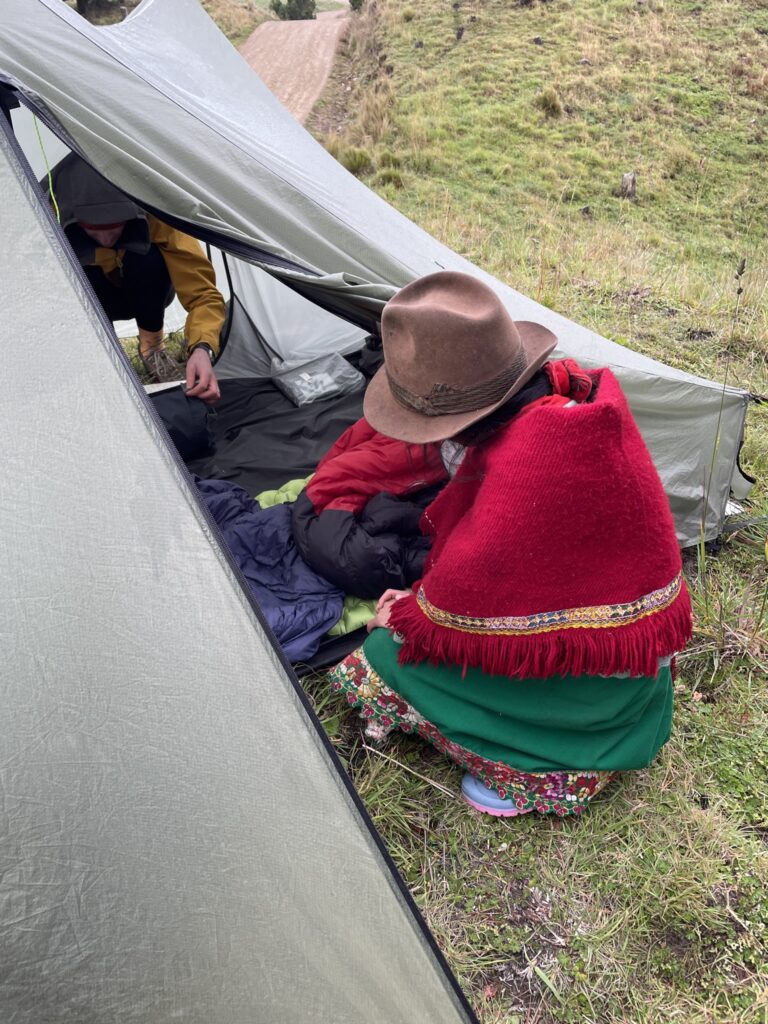
Buoyed by this beautiful encounter and sad to leave the highlands of Ecuador behind us, we descended down to Achupallas for lunch where the town was at the beginning of a two day celebration, there is something very special about being welcomed by a parade and fire crackers! An incredible gorge descent took us down below 2,500m for the first time since Quito. It was bye bye highlands, hello paved roads and the Pan American highway. With options for this last section significantly narrowed, the TEMBR route spends a lot more time on tarmac. The upside being we treated ourselves to a massive Chinese feast in Chunchi, which we combined with pre and post dinner ice cream. The following day along the PanAm was the worst day of the trip for me so far, I’d become so used to the peace and space of the mountains that I became completely overwhelmed by the aggression of the dogs along the highway. As it was much more densely populated there were more houses, more dogs and nowhere to escape to with cars coming up and down the road. By mid afternoon I broke down in tears. The dogs were completely loco, untrained and didn’t respond to any shouting, stopping or their owner attempting to call them back. Supposedly pets, but totally feral. We called it a day early in El Tambo which wasn’t ideal and would add an extra half day for us to reach Cuenca.
A short 10km from El Tambo we stopped at the Cañari and Incan ruins at Ingapirca, an ancient site where one can learn a thing or two about how to build a solid drystone wall to last a few centuries. The walking tour of the site lasted 45 minutes which was about all we could take of the obnoxious American tourists before scurrying off for lunch. The final stretch towards Cuenca took us along an old railway track then a direct line over several small valleys towards the city.
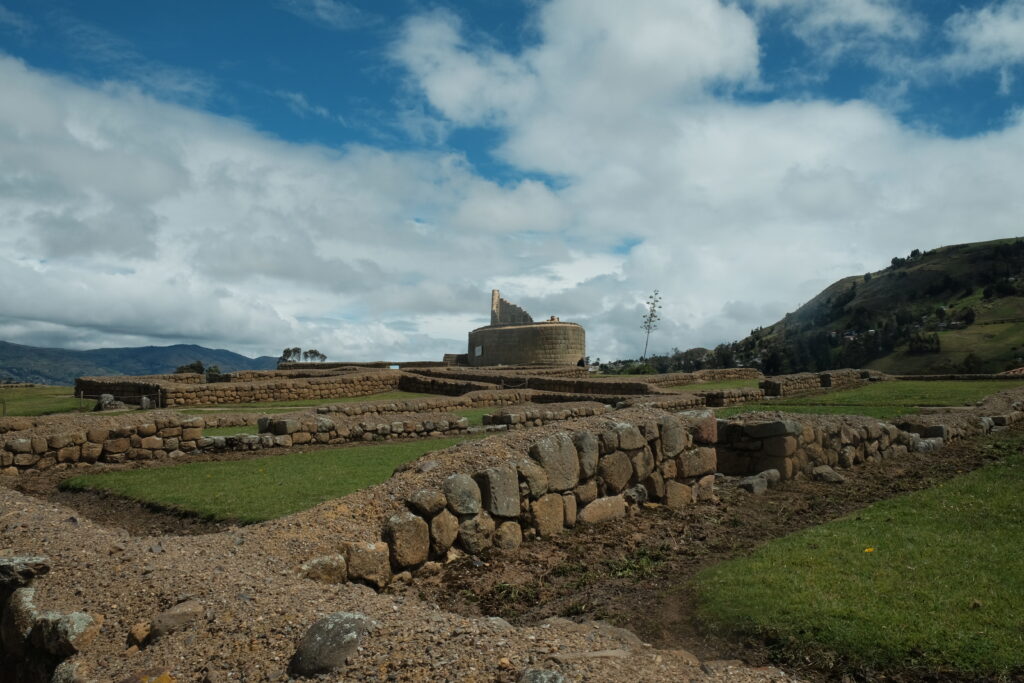
We would not reach the town tonight so were on the lookout for somewhere to pitch in one of the aforementioned valleys. As Liam was waiting for me to push my bike over a particularly steep section, someone shouted ‘shots’ and thrust a measure of scotch into his hand, I was duly expected to follow suit when I reached him! Daniel and his family were having a reunion, a belated fathers’ day celebration. When they learned that we were going to camp in some as yet unknown location they invited us to stay and to join in! After some fruit and an introduction to everyone, we showered and joined them for dinner. Cuy (guinea pig) was on the menu! Liam had been keen to try some since we first started seeing it in southern Colombia, but I had been a little unsure. I couldn’t think of a better way to try this famous local dish! Daniel had lived for 25 years in Canada and was a Canadian citizen,; he was enjoying having some outsiders to speak to about his experiences, of moving to Canada to work in the construction industry and how that had enabled him to save for a better life. He also shared his views on political and beaocratic corruption in Ecuador and the system of compulsory voting. After the perros bravos of the last two days I was particularly enjoying the company of Marcelo the family puppy, inadvertently giving him his first taste of long distance cyclist as he affectionately nibbled my finger.

All that remained was a half day ‘easy’ riding to Cuenca, however, this part of the route did not flow at all. It had all the hallmarks of a route that has been generated on an online planner by clicking between two points and selecting the most direct path between them with no regard for what this might mean for the elevation profile! We’d noticed that as we approached the city the towns had become more lively and the houses much more grand and well kept; there is clearly a sphere of wealth around the city. We rode into Cuenca along the river passing other cyclists, dog walkers and joggers. Gone were the female elders clad in traditional dress walking their pigs along the road and in were the 20 something hipsters with air pods and trendy trainers. I still can’t get my head around quite how stark the rural-urban divide is in Ecuador.

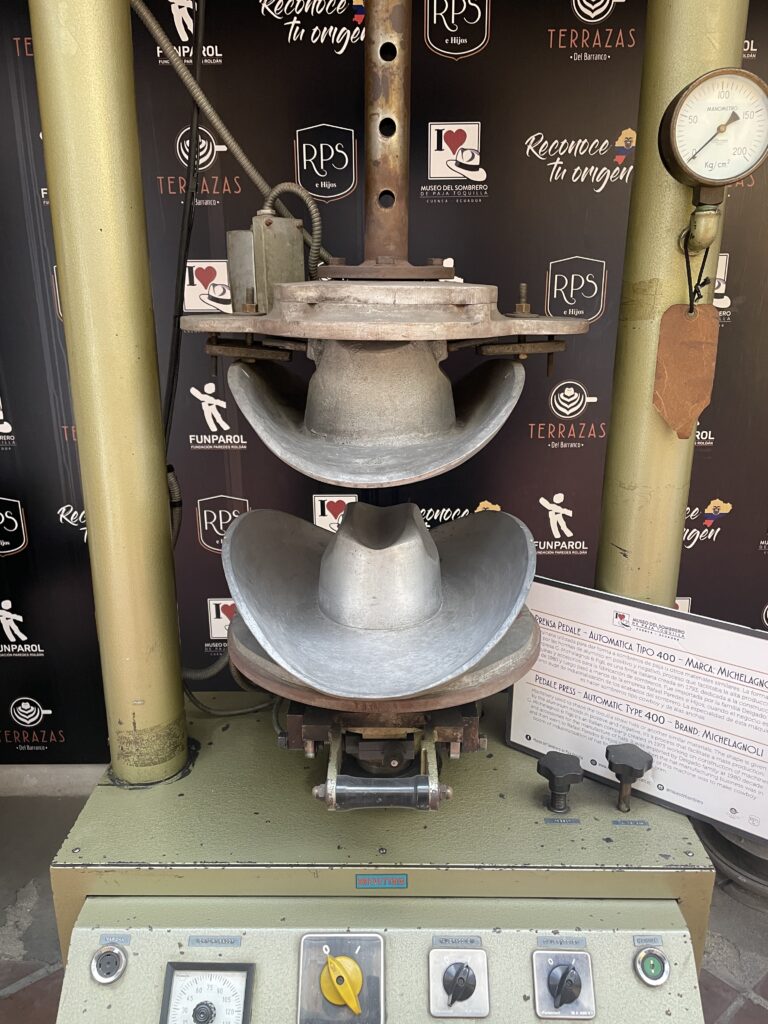
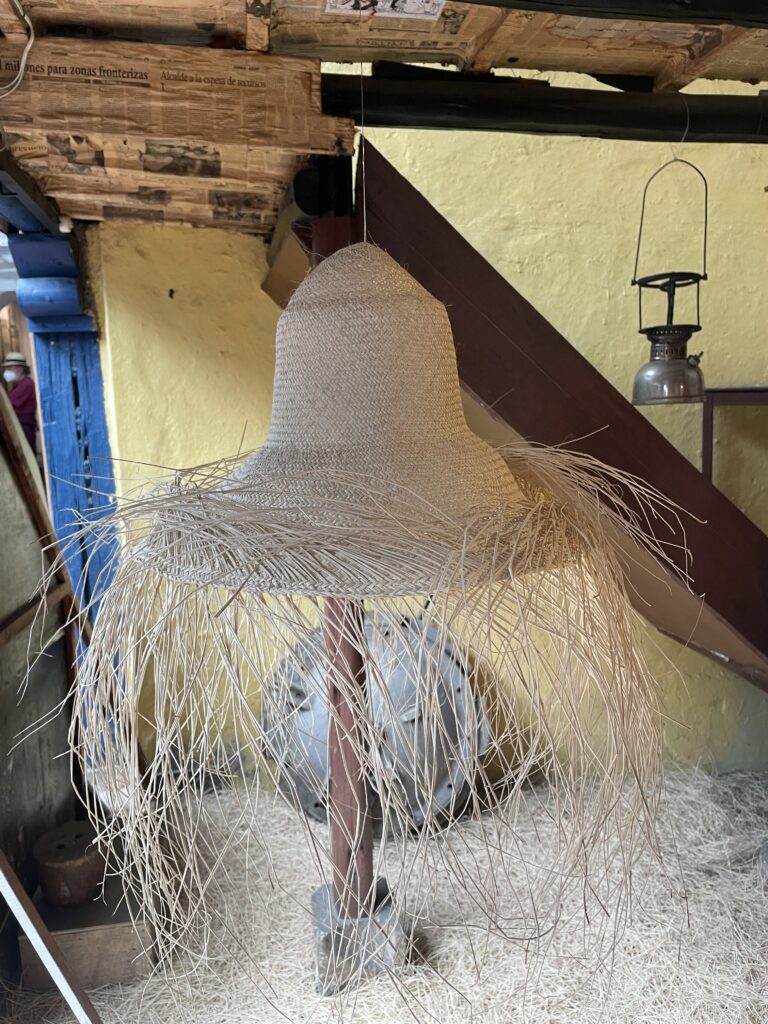
Some of our Cuenca highlights include meeting up with local Jorge, who we passed out on a ride near Ingapirca and swapped numbers. He took us to the Museo Del Sombrero to see how Panama hats are made, to the market to have our bad energy cleansed in a traditional Incan ritual, some traditional hornado, guayaba and strawberry cream, to sample some holy water, traditional Soda from the chemists and the traditional ice cream of Cuenca: Amor Bruyo. We also visited the Pumapungo Museum where we saw many anthropomorphised ceramics, the famous shrunken heads or ‘tsantsas’ considered sacred by the Shuar and Achuar people, and an interesting exhibition from the Ecuadorean national bank on money (we’d been wondering how the dollar had come to be). In a typical turn of colonialism I’d actually seen tsantsas as a child in the Pitt Rivers museum in Oxford, which have since been taken down because it was found they promoted colonial thoughts and reactions. Of course, the white man has since told the indigenous people that they cannot do this anymore and while the practices and ceremonies continue with sloth heads it does trigger a few cultural and intellectual dilemmas. Nevertheless, Cuenca is an incredibly beautiful and compact city, easily explored on two feet without much of a plan.
Another personal Cuenca highlight for me was picking up a new camping mattress, huge thanks to Daniel from Warmshowers for assisting with this! I am very excited at the prospect of sleeping comfortably in the tent again. I opted for a Sea To Summit Etherlight XT which was one of the limited options available on Amazon.com that could be shipped to Ecuador. I shall never again give Thermarest any of my hard earned money!

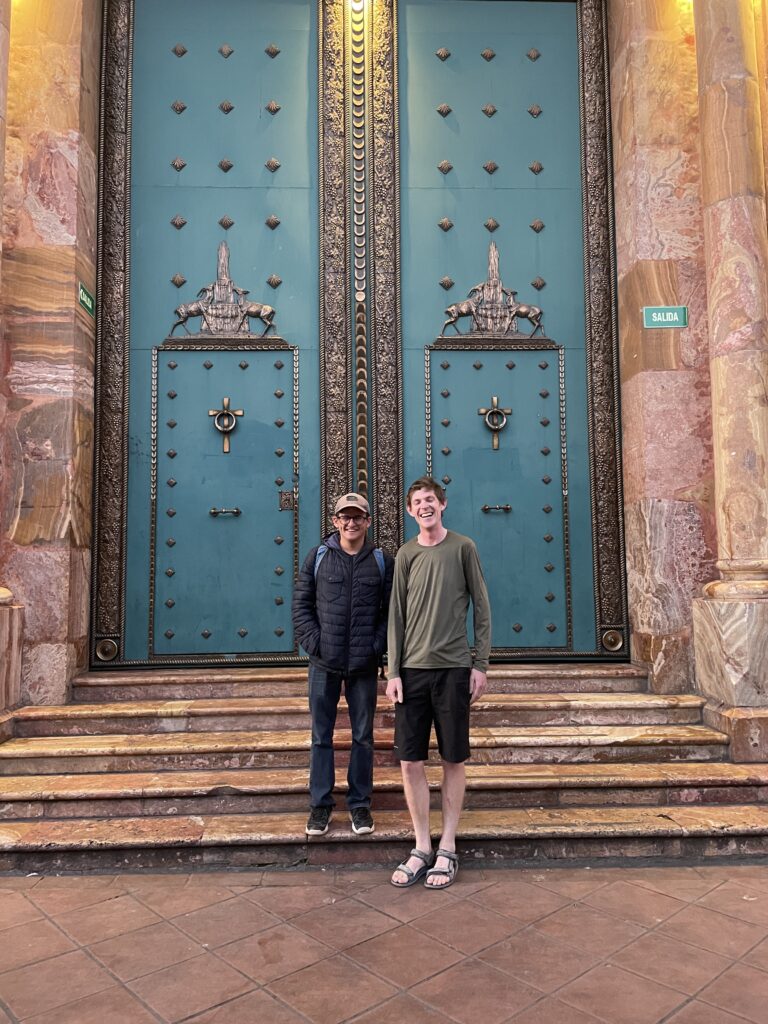






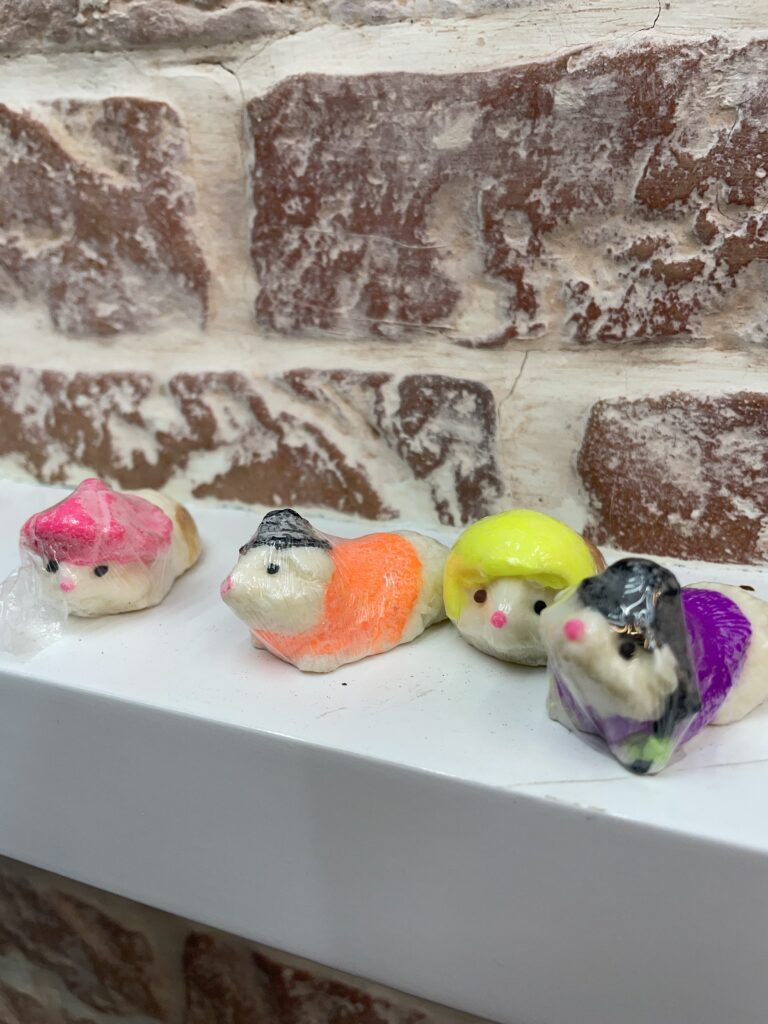
We’ve had a fabulous few days in Cuenca. I could quite happily stay here for a week, but Liam is keen to keep moving and for us not to get too soft. We have decided that on reflection, we came to the Andes to ride our bikes in the mountains and the last few days on pavement sandwiched between barking dogs and cars has not been enjoyable, so we will take a bus to Loja to skip out some more road and then ride the final 200km to the Peruvian border.

